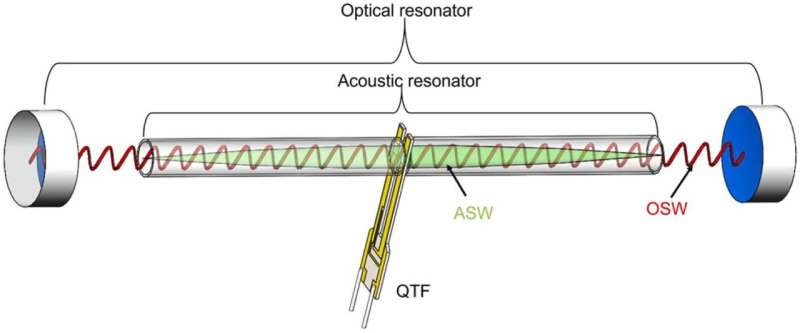Working principle of doubly resonant PAS. ASW: acoustic standing wave; OSW: optical standing wave; QTF: quartz tuning fork. The amplitude of the OSW is modulated at the resonant frequency of the QTF. The geometry of the acoustic resonator is designed according to the acoustic frequency. Credit: Photoacoustics (2022). DOI: 10.1016/j.pacs.2022.100387
Gas sensors based on photoacoustic spectroscopy (PAS) have advantages of tunable diode laser absorption spectroscopy (TDLAS), such as high sensitivity, high selectivity, and wide dynamic range. The sensor performance required is increasingly higher in practical applications.
Numerous works have focused on either acoustic resonator to enhance acoustic wave or optical resonator to enhance optical wave. However, the sensitivity and dynamic range cannot be simultaneously improved.
In a recent study published in Photoacoustics, Dr. WANG Zhen and Prof. WANG Qiang from Changchun Institute of Optics, Fine Mechanics and Physics (CIOMP) of the Chinese Academy of Sciences (CAS) developed a novel gas sensor based on doubly resonant PAS, which combines optical and acoustic resonators in a centimeter-long configuration and leverages on a double standing wave effect. Both acoustic and optical waves are significantly enhanced by several orders of magnitude.
With the resonance between the incident laser frequency and the longitudinal cavity mode of an optical resonator, a pair of resonator mirrors forms a standing optical wave. A significantly built-up laser power can be expected from the high-finesse optical resonator, which directly amplifies the photoacoustic signal. The intensity modulation of the incident laser has the same resonant frequency as the transducer. The generated acoustic wave is enhanced by two orders of magnitude in a specifically designed one-dimensional acoustic resonator.
The PAS-1f signal of the C2H2 line at 1531.6 nm in three different configurations was measured under the same experimental conditions. The combined opto-acoustic amplification provided an enhancement factor of 105. The linear response of the sensor was tested with different C2H2/N2 mixtures, and the sensor showed a very good linear response from 1 ppb to 50 ppm. The Allan–Werle deviation analysis was conducted to evaluate the long-term stability and the minimum detection limit. The noise equivalent concentration (NEC) can be improved to 0.5 ppt at an averaging time of 300 s, leading to a NEA coefficient of 5.7×10-13 cm-1. As a result, the proposed photoacoustic gas sensor achieves a dynamic range of 1.0×108.
Compared with the state-of-the-art PAS gas sensors, the developed sensor achieves a record sensitivity and dynamic range, which provides a powerful tool for scientific explorations.
More information: Zhen Wang et al, Doubly resonant sub-ppt photoacoustic gas detection with eight decades dynamic range, Photoacoustics (2022). DOI: 10.1016/j.pacs.2022.100387
Provided by Chinese Academy of Sciences
























